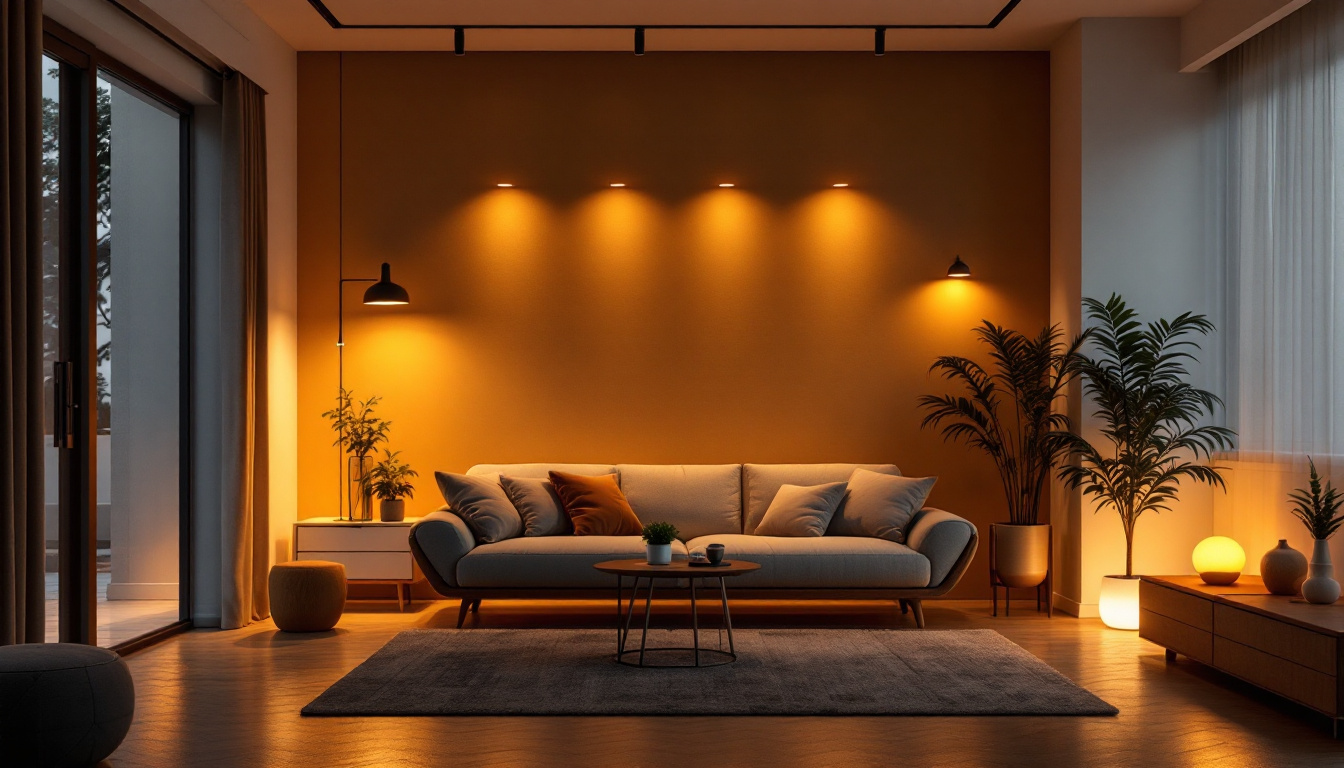
Lighting contractors play a crucial role in enhancing the safety, security, and aesthetic appeal of residential and commercial properties. Among the various lighting solutions available, motion sensor lamps have gained significant popularity due to their energy efficiency and convenience. This article explores proven methods for lighting contractors to effectively implement motion sensor lamps in various applications.
Motion sensor technology has evolved significantly, offering a variety of options tailored to different environments and needs. At its core, motion sensors detect movement within a specified range and trigger lighting accordingly. This not only conserves energy but also enhances security by illuminating areas when movement is detected. The integration of these sensors into smart home systems has further transformed their functionality, allowing for remote monitoring and control through smartphones or home automation systems, making them an essential component in modern security setups.
There are several types of motion sensors that lighting contractors should be familiar with. Passive Infrared (PIR) sensors are the most common, detecting heat emitted by objects, such as humans and animals. Ultrasonic sensors emit sound waves and measure their reflection, allowing them to detect motion even in areas with obstacles. These sensors are particularly effective in environments where visibility may be compromised, such as in dark hallways or storage rooms.
Another type is the dual-technology sensor, which combines PIR and ultrasonic technologies for improved reliability. By understanding the strengths and limitations of each type, contractors can recommend the most suitable option for their clients’ specific needs. For instance, in outdoor settings where weather conditions might affect performance, a dual-technology sensor can provide a more consistent response, ensuring that lights activate only when necessary, thus preventing unnecessary energy consumption.
When selecting motion sensor lamps, several key features should be considered. adjustable sensitivity settings allow users to customize how sensitive the sensor is to movement, which can be particularly useful in areas with frequent foot traffic. Additionally, timers can be set to determine how long the light remains on after activation, providing flexibility for various applications. This feature is especially beneficial in commercial spaces where lighting needs may vary throughout the day, enabling businesses to optimize their energy usage.
Another important feature is the range of the sensor, which can vary significantly between models. Contractors should assess the area where the lamp will be installed to ensure that the chosen sensor has an adequate detection range. Furthermore, it is crucial to consider the mounting height and angle, as these factors can significantly influence the sensor’s effectiveness. For example, installing a sensor too high may limit its ability to detect lower movements, while an incorrect angle could lead to blind spots, reducing overall security and functionality. Understanding these nuances can help contractors provide tailored solutions that meet their clients’ unique requirements.
Motion sensor lamps offer numerous benefits that make them an attractive option for both contractors and their clients. These advantages extend beyond mere convenience, impacting energy consumption, safety, and overall satisfaction.
One of the primary benefits of motion sensor lamps is their energy efficiency. By only activating when movement is detected, these lamps significantly reduce energy consumption compared to traditional lighting solutions that remain on continuously. This not only lowers electricity bills but also contributes to a more sustainable environment.
For contractors, promoting energy-efficient solutions can enhance their reputation and appeal to environmentally conscious clients. Additionally, many regions offer incentives for energy-efficient installations, providing further financial benefits for both contractors and clients. The long lifespan of LED motion sensor lamps also means less frequent replacements, reducing waste and maintenance costs over time. As technology advances, these lamps are becoming even more sophisticated, with features such as adjustable sensitivity and timers, allowing users to customize their lighting experience based on specific needs.
Motion sensor lamps also play a critical role in enhancing security. By illuminating dark areas when movement is detected, they deter potential intruders and provide peace of mind for property owners. This feature is particularly valuable in residential settings, where safety is a top priority.
Lighting contractors can leverage this security aspect in their marketing efforts, emphasizing how motion sensor lamps can protect homes and businesses alike. Proper placement of these lamps can create a well-lit perimeter, making it more difficult for intruders to approach unnoticed. Furthermore, many modern motion sensor lamps come equipped with smart technology, allowing homeowners to receive alerts on their smartphones when motion is detected, thus providing an additional layer of security. This integration with home automation systems not only enhances safety but also adds a level of convenience, allowing users to control their lighting remotely and monitor their property in real-time.
To ensure optimal performance and longevity of motion sensor lamps, proper installation is essential. Lighting contractors should adhere to several best practices during the installation process to maximize the benefits of these devices.
The placement of motion sensor lamps is critical to their effectiveness. Ideally, sensors should be installed at a height of 6 to 8 feet, allowing for optimal detection range. Additionally, they should be positioned to cover high-traffic areas, such as walkways, driveways, and entry points.
Contractors should also consider environmental factors that may affect sensor performance. For instance, installing sensors near trees or shrubs may lead to false triggers due to movement from branches or animals. Assessing the surrounding environment before installation can prevent these issues. Furthermore, it’s beneficial to take into account the angle of the sensor; a slight tilt can enhance detection capabilities, ensuring that the sensor captures movement from various directions. This attention to detail not only improves functionality but also enhances the safety and security of the property.
Proper wiring is essential for the reliable operation of motion sensor lamps. Contractors should ensure that all connections are secure and that the wiring is suitable for outdoor use if the lamps are being installed in external areas. Using weatherproof connectors and enclosures can help protect against moisture and corrosion.
Furthermore, contractors should be mindful of the power source. Depending on the type of motion sensor lamp, options may include hardwired systems or battery-operated models. Understanding the power requirements will facilitate a smoother installation process. For hardwired systems, it’s crucial to check the circuit load to avoid overloading, which can lead to malfunctions. In contrast, battery-operated models require regular maintenance to ensure batteries are replaced promptly, as a dead battery can render the sensor ineffective. Additionally, integrating solar-powered options can be an eco-friendly alternative, reducing reliance on traditional power sources while still providing reliable lighting solutions.
Regular maintenance is vital for ensuring the longevity and functionality of motion sensor lamps. Lighting contractors should educate their clients about basic maintenance tasks and troubleshooting techniques to address common issues.
One of the simplest yet most effective maintenance tasks is regular cleaning of the sensor lenses. Dust, dirt, and debris can accumulate on the lens, obstructing the sensor’s ability to detect motion. Contractors should recommend that clients clean the lenses periodically to maintain optimal performance.
In addition to cleaning the lenses, it is also essential to check the fixtures for any signs of wear or damage. Regular inspections can help identify potential issues before they escalate, ensuring that the lighting system remains reliable.
Despite proper installation and maintenance, issues may still arise with motion sensor lamps. Common problems include false triggering, failure to activate, or lights that stay on continuously. Contractors should be prepared to troubleshoot these issues effectively.
For false triggering, contractors can advise clients to adjust the sensitivity settings or reposition the sensor to minimize interference from moving objects. If the lights fail to activate, checking the power source and ensuring that the sensor is not obstructed are crucial steps. Educating clients on these troubleshooting techniques can enhance their satisfaction and reduce the need for service calls.
As technology continues to advance, integrating motion sensor lamps with smart home systems has become increasingly popular. This integration offers enhanced control and convenience for users, making it an attractive option for lighting contractors to consider.
Many modern motion sensor lamps are designed to be compatible with smart home systems, allowing users to control their lighting remotely via smartphone apps. This feature enables users to customize settings, monitor energy usage, and receive notifications when motion is detected.
Contractors should stay informed about the latest smart home technologies and recommend compatible motion sensor lamps to clients interested in upgrading their lighting systems. This not only enhances the functionality of the lighting but also positions contractors as knowledgeable professionals in a rapidly evolving market.
Integrating motion sensor lamps with smart technology provides several benefits. For instance, users can create schedules to automate lighting based on their routines, ensuring that lights are only on when needed. Additionally, smart sensors can be programmed to send alerts to users’ smartphones, enhancing security by notifying them of any detected movement.
From a contractor’s perspective, promoting smart integration can differentiate their services in a competitive market. By offering advanced lighting solutions, contractors can attract tech-savvy clients and expand their customer base.
Motion sensor lamps are a valuable addition to any lighting contractor’s toolkit, offering energy efficiency, enhanced security, and convenience. By understanding the technology, benefits, and installation best practices, contractors can effectively implement these solutions for their clients.
Moreover, staying informed about advancements in smart technology will allow contractors to offer cutting-edge solutions that meet the evolving needs of modern consumers. As the demand for energy-efficient and technologically advanced lighting solutions continues to grow, lighting contractors who embrace motion sensor lamps will be well-positioned to succeed in the industry.
Ready to elevate your lighting solutions with the efficiency and sophistication of motion sensor lamps? At LumenWholesale, we provide lighting contractors like you with the highest quality, spec-grade lighting products at prices that can’t be beaten. Say goodbye to unnecessary markups and hello to a vast selection of reliable, high-performance lighting that meets the strictest industry standards. Plus, with free shipping on bulk orders, you can stock up on premium lighting without worrying about hidden fees. Don’t compromise on quality or value—choose LumenWholesale for the perfect blend of affordability and convenience. Take the next step in advancing your lighting projects by visiting Wholesale Lighting at the Best Value today.

Discover the answers to lighting contractors’ most frequently asked questions about electrical wall sconces.

Discover the key factors that distinguish leading lighting contractors in the art of cable pulling.

Discover why LED room lighting is essential for any successful lighting project.

Discover how lighting contractors can enhance their projects and boost efficiency with Rab Lighting solutions.